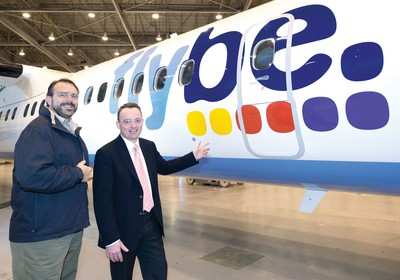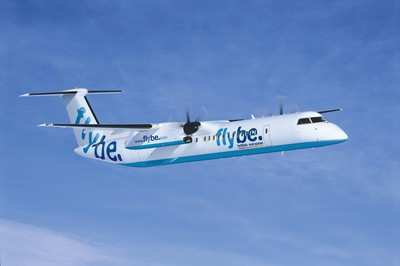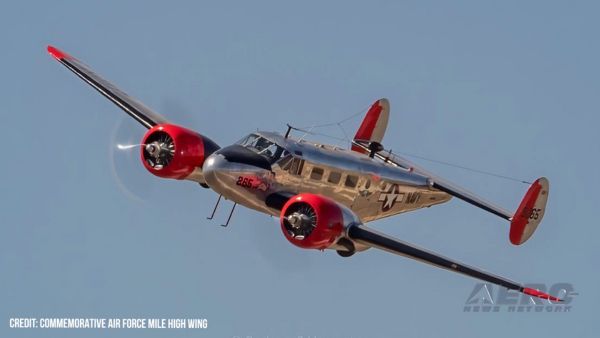Aircraft Equipped With Active Noise Control System
UK airline Flybe has taken delivery of its 50th Q400 airliner.
The aircraft is equipped with the 1,000th installation of Ultra
Electronics’ Active Noise Control (ANC) system which is
called the Active Noise and Vibration Suppression (ANVS) system on
Q400 and other Bombardier Q-Series aircraft. Since the introduction
of the ANVS system to Bombardier’s Dash 8 aircraft in 1996,
the aircraft have been known as Q-Series airliners, signaling a new
era in turboprop passenger comfort. The “Q”, obviously,
means quiet.

Flybe, previously known as British European, placed an initial
order for four Q400 airliners in March 1999. Subsequent orders were
announced in 2003, 2005 and 2007, confirming Flybe as the largest
operator of the aircraft type. Flybe which operates 190 routes in
13 countries, carried 7.5 million passengers in 2008.
“The Bombardier Q400 airliner has been the dominant factor
in our growth and success,” said Jim French, Chairman and
Chief Executive Officer of Flybe. “It has excellent operating
economics, amazing performance, and the ANVS system contributes
significantly to its outstanding passenger comfort.”
“Flybe operates the largest fleet of the world's most
technologically advanced turboprop,” said Gary R. Scott,
President, Bombardier Commercial Aircraft. “The Q400 airliner
is optimized for short-haul service and Flybe’s successful
experience with our high-speed turboprop's capabilities in European
markets has set a standard which other airlines around the world
can follow.”
Firm orders for the Q400 airliner have reached 347 aircraft,
with 233 having been delivered as of January 31, 2009.

The Active Noise and Vibration Suppression (ANVS) System The
ANVS system is the product of a program by Bombardier Aerospace
that began in 1988 to find a solution for the noise and vibration
concerns in turboprops. For the next few years, state-of-the-art
systems were evaluated. The results, while promising, did not
deliver the level of comfort that Bombardier wanted.
By October 1993, Ultra Electronics Ltd. of Cambridge, England
had conducted successful demonstrations of Active Tuned Vibration
Absorbers (ATVA) on a submarine and it was decided to try them out
in the Dash 8 turboprop. By this time it was recognized that much
of the cabin noise was generated by vibrations. Eliminating
vibrations would help eliminate noise.
In mid-1995, after exhaustive testing, the ANVS system was
perfected. It goes to the source of the noise — airframe
vibration induced by pressure pulses from the propeller blades
“beating” against the fuselage. Microphones concealed
in the passenger cabin measure noise levels which are sent to an
onboard microprocessor, together with propeller rpm and cabin
pressure differential. The microprocessor then signals ATVAs
attached to the fuselage frames to initiate out-of-phase counter
vibrations to diminish the magnitude of the original
vibrations. Therefore, the noise-generating vibrations are dampened
at their source so that most noise never enters the passenger
cabin. An improved propeller synchrophaser with an accuracy of +/-5
degrees reduces the pressure pulses at the outset.
In conjunction with the ANVS system, the Dash 8 cabin was
re-designed to eliminate or reduce bothersome rattles and buzzes.
Interior components are “soft mounted” using
elastomeric snubbers, while joints between components are
acoustically sealed. Modified sidewall and floor panels reduce
resonance. New thermal blankets — the insulation surrounding
the cabin structure — have improved acoustical properties to
absorb noise better.
 ANN FAQ: Follow Us On Instagram!
ANN FAQ: Follow Us On Instagram! Classic Aero-TV: Innovation By Avilution Pilots Care About Results
Classic Aero-TV: Innovation By Avilution Pilots Care About Results Aero-News: Quote of the Day (05.09.25)
Aero-News: Quote of the Day (05.09.25) ANN's Daily Aero-Term (05.09.25): Estimated (EST)
ANN's Daily Aero-Term (05.09.25): Estimated (EST) ANN's Daily Aero-Linx (05.09.25)
ANN's Daily Aero-Linx (05.09.25)




